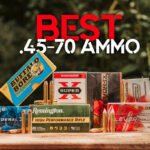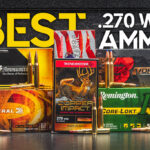
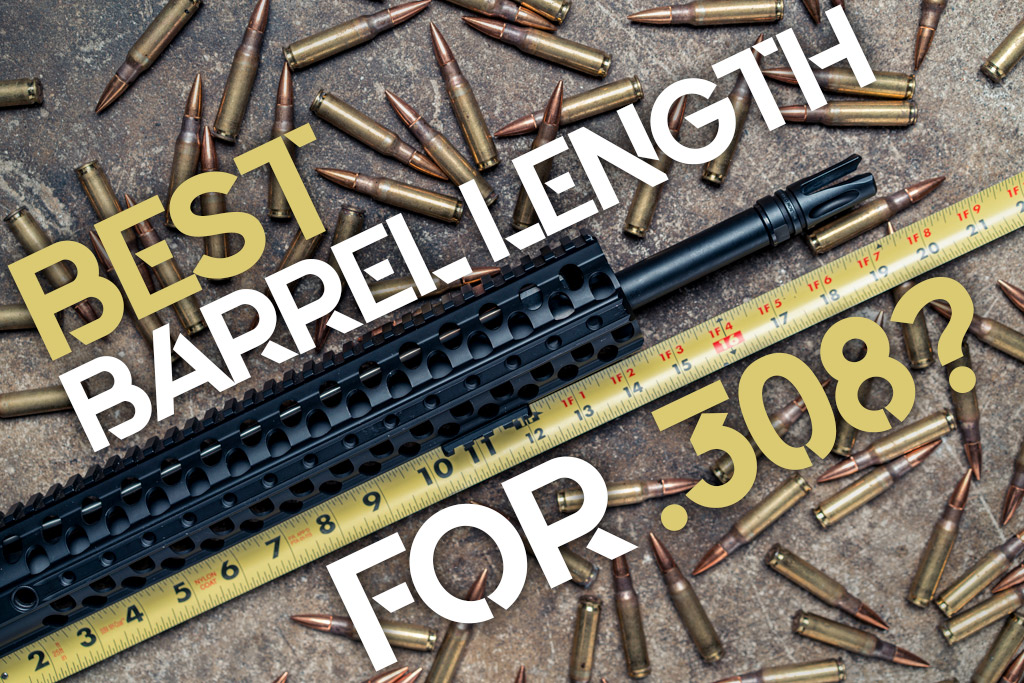
Perhaps you’ve felt overwhelmed looking for the best barrel length for 308? From bolt actions to semi-automatics, the .308 is a versatile system. Below, we’ll talk about many aspects of the .308’s barrel length, including the significance of twist rate, velocities with various barrel lengths, and different uses for long and short barrels.
Gun owners enjoy the .308’s versatility as a high-powered, short-action round. It’s a cartridge that runs well in a variety of different rifle types, and various barrel lengths. When it comes to options, you can find a bullet type for just about any purpose. Availability for the cartridge is above average, and it’s more affordable than many comparable rounds which utilize the same bullet.
The best barrel length for a .308 depends on the firearm’s intended purpose. If you’re primarily a hunter chasing big game in the open range, you might consider a medium to a long-barreled rifle. However, if you’re using the .308 as an all-purpose or self-defense firearm, using a slightly shorter barrel will make the gun easier to handle.
Best Barrel Length For 308?
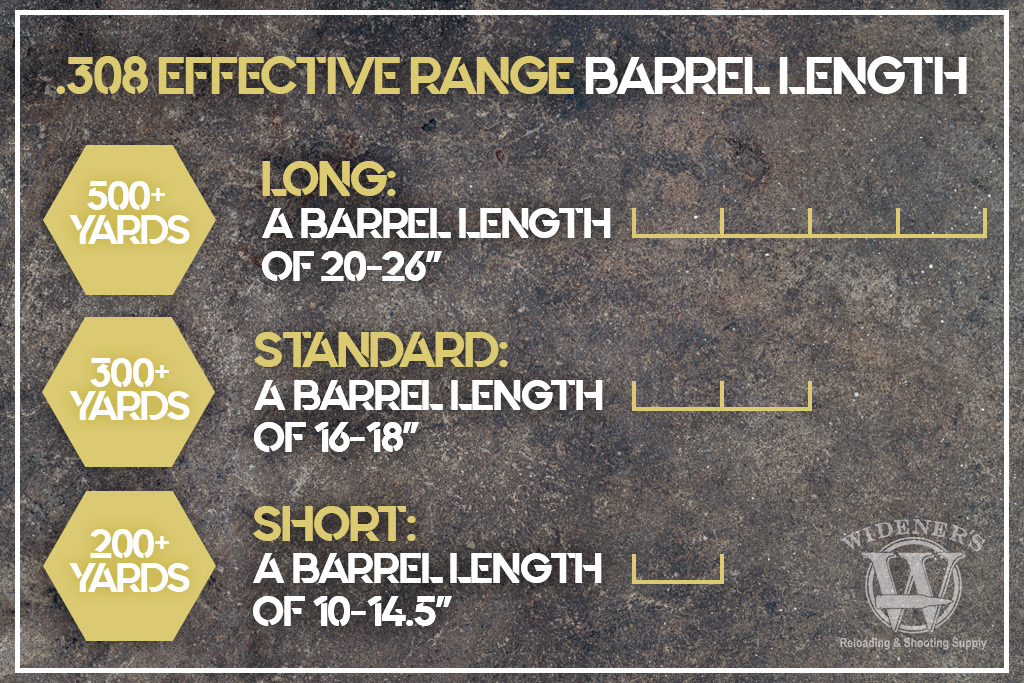
Choose the barrel length that works best for your intended purpose and start training to reach your goals.
There are three barrel-length categories we’ll be taking a look at in this article. Short barrels (10-14.5″), which are commonly found on pistols, or SBRs. Standard length barrels (16-18″) which are the most common lengths. As well as long barrels (20-26″), which are generally used for precision applications. While technically a “long barrel” is anything sixteen-plus inches, to make things simple, in this article we’ll acknowledge their length as twenty inches or greater.
- Long: A barrel length of 20-26″
- Standard: A barrel length of 16-18″
- Short: A barrel length of 10-14.5″
First, many hunters or long-range shooters have a bolt action .308 with a barrel length of 20-26″. The .308 competes with the 30-06 as a well-rounded hunting caliber. However, the .308 is also popular in semi-automatic rifles.
This leads us to our second category of barrel length, .308s with a barrel length of 16-18″. These standard semi-autos are great for all-around use. They’re easy to carry, weigh less, and are easy to maneuver.
Finally, the shortest barrels .308s range from 10-14.5″ and are commonly known as .308 pistols. These are ultra-portable and ideal for home or personal defense. Depending on how they are set up, they can also be classified as short-barreled rifles.
Each of these barrel-length categories has its strengths and weaknesses. Now, let’s talk about the common uses for these various .308 barrel lengths.
.308 Barrel Lengths Compared
Barrel length isn’t the only factor that affects accuracy, far from it in fact. A high-quality and carefully tuned barrel can produce consistent accuracy even if it’s slightly shorter. Barrels with the best accuracy have a good balance of stiffness and thickness in diameter. There are endless combinations of barrel lengths, material types, rifle styles, and ammunition that all contribute to a gun’s accuracy. With that said, there are some industry-accepted norms to bear in mind. We’ll address some of those below.
Long 20-28″ .308 Barrel Uses
Firearm owners use these barrels for longer-range shooting, usually 100 to 500-yards. The longer barrel gives the ammunition more velocity (see more about that in the next section) and will carry over long distances. These longer barrels are popular with competition shooters or big game hunters covering large areas.
Standard 16-18″ .308 Barrel Uses
A .308 with a 16-18″ barrel provides sufficient accuracy from 100 to 300-yards, making it a solid all-purpose system. With this barrel length, you have a good home-defense option while still having the range for hunting.
The AR-10 with a standard barrel length is a popular platform for .308 calibers. If you’d like, you can read about the differences between the AR-10 and the AR-15.
Short 10-14.5″ .308 Barrel Uses
Any barrel below 16″ can be classified as a pistol. These guns are made with ultimate portability and usability in mind. With a folding stock, some of these rifles may fit within a standard backpack.
What’s the appeal of the short-barreled .308? It gives you the ability to carry a high-powered rifle cartridge in a convenient package. While you might lose accuracy and power at greater distances, the 10-14.5″ .308 still offers a lot of use in the 100-200 yard plus range.
How much power will you lose with a decreased barrel length? We’ll show you a table that outlines the relationship between barrel length and velocity in the next section.
Barrel Length Velocity
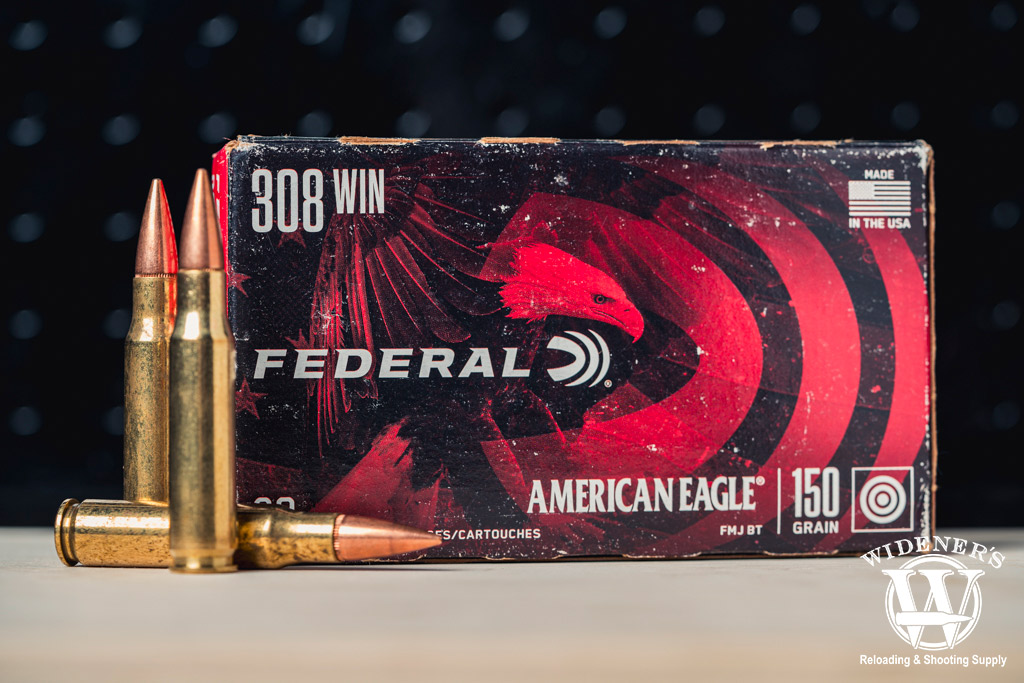
Federal’s American Eagle 150gr .308 Win FMJ ammo is a solid performer with an entry-level price.
Comparison for 150-grain FMJ .308
Velocity plays a huge role in the transfer of energy. The faster an object travels, the more energy it will transfer when it strikes another object. An unfortunate way to understand this is car accidents – the faster the car is traveling, the more likely the occupants will be seriously injured in a crash.
Below, you’ll find the velocity differences for a 150-grain FMJ .308 round from 14.5-inch to 26-inch barrels.
American Eagle Rifle 308 Win 150 Grain
| Barrel Length | Caliber | Bullet Type | Bullet Weight | Muzzle (Velocity/Energy) | 100 Yards (Velocity/Energy) | 200 Yards (Velocity/Energy) | 300 Yards (Velocity/Energy) |
|---|---|---|---|---|---|---|---|
| 14.5″ | .308 Win | FMJ | 150gr | 2,500 FPS/ 2,082 FT LBS | 2,285 FPS/ 1,739 FT LBS | 2,075 FPS/ 1,434 FT LBS | 1,860 FPS/ 1,152 FT LBS |
| 16″ | .308 Win | FMJ | 150gr | 2,640 FPS/ 2,321 FT LBS | 2,420 FPS/ 1,950 FT LBS | 2,210 FPS/ 1,627 FT LBS | 1,992 FPS/ 1,322 FT LBS |
| 18″ | .308 Win | FMJ | 150gr | 2,680 FPS/ 2,392 FT LBS | 2,455 FPS/ 2,007 FT LBS | 2,240 FPS/ 1,671 FT LBS | 2,017 FPS/ 1,355 FT LBS |
| 20″ | .308 Win | FMJ | 150gr | 2,760 FPS/ 2,537 FT LBS | 2,535 FPS/ 2,140 FT LBS | 2,320 FPS/ 1,793 FT LBS | 2,097 FPS/ 1,465 FT LBS |
| 24″ | .308 Win | FMJ | 150gr | 2,820 FPS/ 2,648 FT LBS | 2,597 FPS/ 2,246 FT LBS | 2,385 FPS/ 1,894 FT LBS | 2,183 FPS/ 1,587 FT LBS |
| 26″ | .308 Win | FMJ | 150gr | 2,845 FPS/ 2,696 FT LBS | 2,625 FPS/ 2,295 FT LBS | 2,415 FPS/ 1,942 FT LBS | 2,212 FPS/ 1,630 FT LBS |
Using a 150-grain American Eagle cartridge in .308, you’ll get a muzzle velocity of 2,820 FPS and 2,183 FPS at 300 yards from a 24-inch barrel. The energy remains over 2,000 ft-lbs at 100 yards and is 1,587 ft-lbs at 300 yards, dropping to 1,089 ft-lbs at 500 yards. Wind drift sits at .8-inches at 100 yards and is 7.8 inches at 300 yards. Bullet drop becomes noticeable at 300 yards when it falls to 8.0 inches below the point of aim.
The longer the barrel, the more velocity (feet per second) the round can achieve. While these numbers may not look like much on paper, those extra couple hundred FPS can make a big difference.
168gr Match Ammunition Comparison
The barrel’s twist rate is another factor in the bullet’s flight. To prevent accuracy issues, always match barrel length and twist rate with your .308 ammunition. Typically, the barrel (usually stamped on the side) or the gun manufacturer lists recommended rounds for specific barrels. We’ll discuss twist rate in the next section.
Below, you’ll find the velocity differences for a 168-grain FMJ .308 round from 14.5-inch to 26-inch barrels.
Gold Medal Sierra MatchKing 308 Win 168 Grain
| Barrel Length | Caliber | Bullet Type | Bullet Weight | Muzzle (Velocity/Energy) | 100 Yards (Velocity/Energy) | 200 Yards (Velocity/Energy) | 300 Yards (Velocity/Energy) |
|---|---|---|---|---|---|---|---|
| 14.5″ | .308 Win | BT-HP | 168gr | 2,400 FPS/ 2,149 FT LBS | 2,220 FPS/ 1,838 FT LBS | 2,030 FPS/ 1,537 FT LBS | 1,850 FPS/ 1,277 FT LBS |
| 16″ | .308 Win | BT-HP | 168gr | 2,480 FPS/ 2,294 FT LBS | 2,290 FPS/ 1,956 FT LBS | 2,110 FPS/ 1,661 FT LBS | 1,930 FPS/ 1,389 FT LBS |
| 18″ | .308 Win | BT-HP | 168gr | 2,540 FPS/ 2,406 FT LBS | 2,340 FPS/ 2,042 FT LBS | 2,160 FPS/ 1,740 FT LBS | 1,985 FPS/ 1,470 FT LBS |
| 20″ | .308 Win | BT-HP | 168gr | 2,580 FPS/ 2,483 FT LBS | 2,390 FPS/ 2,131 FT LBS | 2,207 FPS/ 1,817 FT LBS | 2,032 FPS/ 1,540 FT LBS |
| 24″ | .308 Win | BT-HP | 168gr | 2,650 FPS/ 2,619 FT LBS | 2,460 FPS/ 2,257 FT LBS | 2,277 FPS/ 1,935 FT LBS | 2,103 FPS/ 1,650 FT LBS |
| 26″ | .308 Win | BT-HP | 168gr | 2,690 FPS/ 2,699 FT LBS | 2,510 FPS/ 2,350 FT LBS | 2,340 FPS/ 2,042 FT LBS | 2,176 FPS/ 1,766 FT LBS |
With a 168-grain Gold Medal cartridge in .308, you’ll get a muzzle velocity of 2,650 FPS and 2,103 FPS at 300 yards from a 24-inch barrel. The energy remains over 2,000 ft-lbs at 100 yards and is 1,650 ft-lbs at 300 yards, and 1,179 ft-lbs at 500 yards. Wind drift sits under 1-inch at 100 yards and is 7.4 inches at 300 yards. Bullet drop is negligible until 300 yards when it falls 8.9 inches below the point of aim.
Understanding Twist Rate
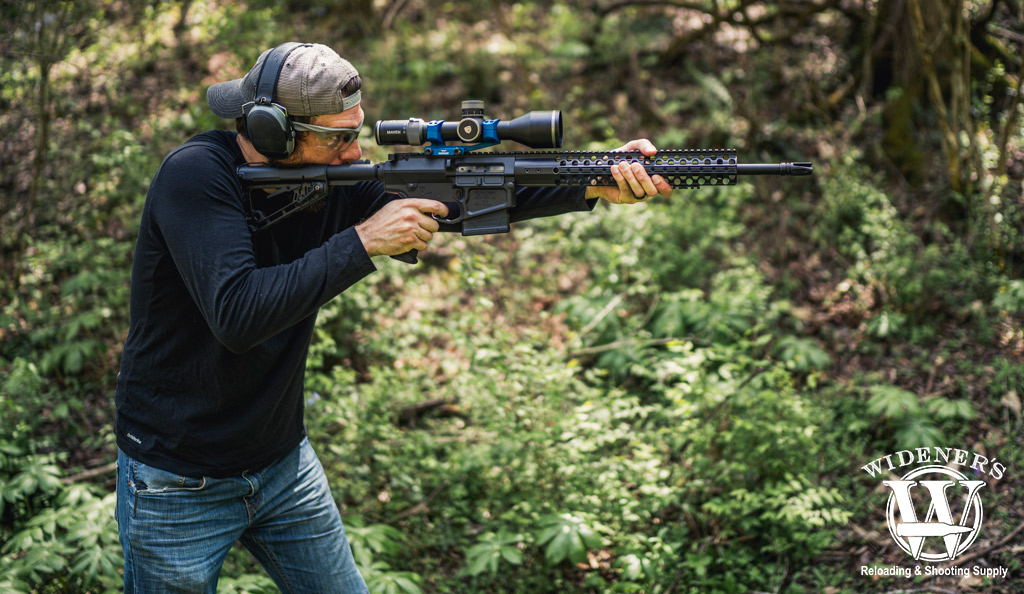
The 1:12 twist rate is the most common for .308 rifle barrels, it works well to stabilize medium-light grain weight bullets.
The barrel’s twist rate can affect the type and length of the barrel you choose for your .308 – what is twist rate? The twist rate represents how many inches of the barrel it takes to twist the round one full rotation.
There’s a lot of advanced mathematics and physics behind twist rate; however, here are the bones of what you need to know: First, most .308 barrels have a twist rate of 1:12 – that means it takes twelve inches of barrel to twist the projectile one time. A 1:10 or 1:12 are the most common barrel twist rates for .308 rifles.
A 1:12 twist rate is actually considered to be slow. However, if you’re shooting heavier grain ammunition, you may want a twist rate around 1:10. Why? Generally, the heavier bullets require a tighter spin to keep them stable. If you don’t get enough spin on the bullet, it could end up wobbling or yawing.
To picture this, think about throwing a football. If you’re a quarterback, you probably know how to throw a tight spiral. With that said, if you don’t know how to throw a football, you could end up throwing a knuckleball, with the football tumbling all over. The same thing happens to bullets if you don’t match your barrel length, bullet grain, and twist rate.
Barrel Materials & Finish Options
Stainless steel dominates as the material of choice for barrel makers. 416-R stainless and 4150 carbon are the two most common steel types used in .308 barrel making. 416-R stainless has the highest-rated machinability and is ideal for high-accuracy applications. 4150 is often referred to as “Mil-Spec” steel and is ideal for high rate of fire applications.
You’ll find black oxide and Cerakote are common external barrel finishes. Black oxide is like dark-colored rust that protects the barrel from corrosion. Cerakote is the name of a popular ceramic-based coating. Cerakote is a solid finish that protects the firearm while also giving you nearly endless options for colors and customization.
For the inside of the barrel, chrome lining is popular to prevent long-term corrosion resistance. If you’re interested, here’s an article to read more about chrome and nitride lining.
Measured Results
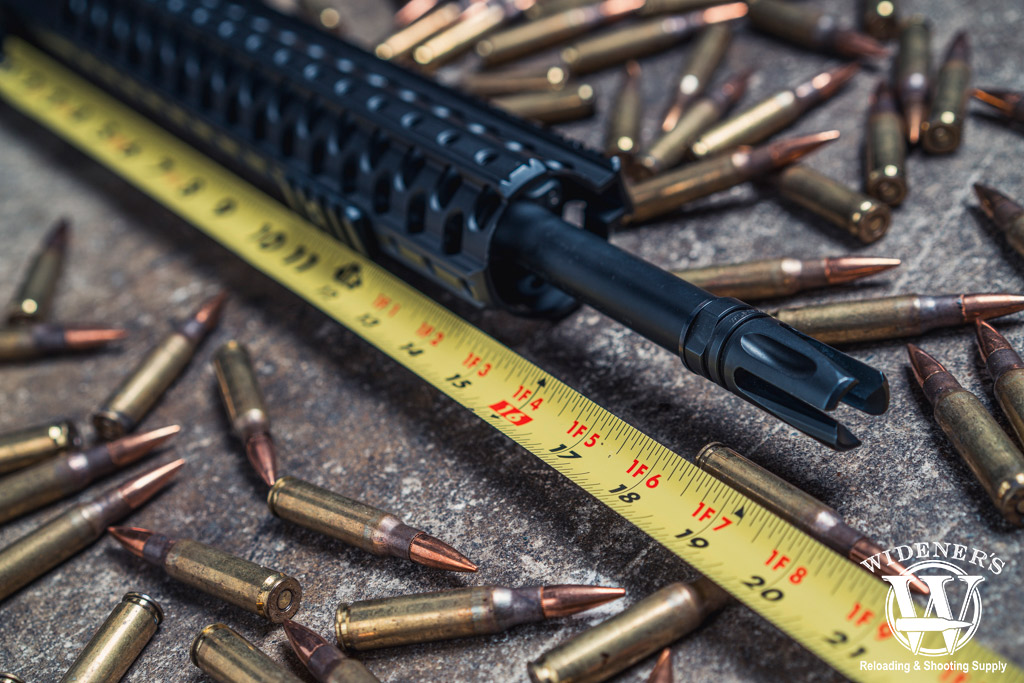
The .308 Win was designed with a 22-24″ barrel in mind, but it still performs admirably in shorter barrels.
If you’re new to the .308 platform, pin down your main purpose (competition, hunting, self-defense, etc.), and use a quality firearm with the best barrel you can find. Don’t lose sleep at night worrying about the advanced mathematical formulas physicists use to tinker with .308 barrels. No matter which barrel length you choose, short, or long, there’s going to be a compromise. Choose the length that works best for your intended purpose and start training.
Focus on learning to operate your firearm safely and efficiently. Try out a few different types of ammo to see what runs the best in your gun. You’ll need practice ammo for your range days, and specific ammo for accomplishing your goals. Don’t forget to budget for an optic. Even if you’re training in close quarters, a good optic makes a big difference. After you’ve sighted your new .308 in, check out this article answering the question, which caliber should you choose for your AR-10 rifle?


